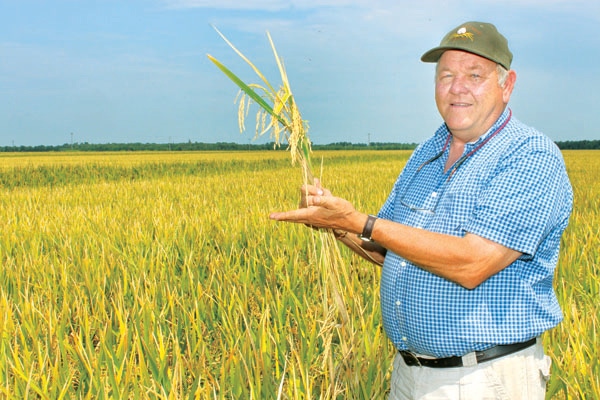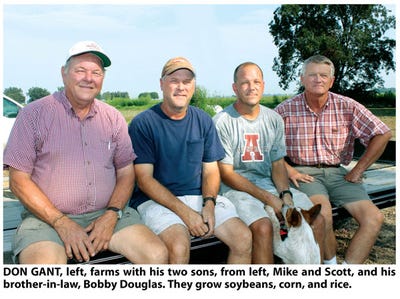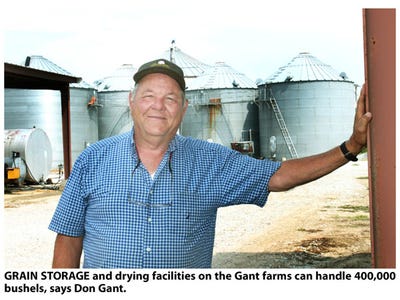
Hands-on management and modern equipment with GPS are key components for Gant Farms, a 6,000-acre soybean, corn, and rice operation at Merigold, Miss.“I can remember when I was growing up, it took a week or 10 days to pull 15-20 acres of corn," says Donald Gant. "Now, one of our combines can harvest that much corn in a couple of hours or less, ready to go into the bins. And, they are much gentler on grain than earlier models."

It’s a steamy late summer morning, corn and soybean harvests are in full swing, and wouldn’t you know it, the grain augur on the bins at Gant Farms headquarters picked this critical time to break.
But Donald Gant is unperturbed.
“Things will work out,” he says calmly, wading through the gaggle of dogs that enthusiastically greeted his arrival on the farm. And sure enough, a while later his cell phone rings with the news that the needed replacement part has been located and repairs can be made expeditiously.
When you’ve got 6,000 acres of corn, beans, and rice to harvest and get into storage, time is money — and anything that throws a monkey wrench in the work routine can mean lost money.
“When we put a combine in a field, we don’t like to stop it for anything,” says Don, who farms with his sons, Mike and Scott, and brother-in-law, Bobby Douglas, in the heart of the Delta at Merigold, Miss. “We don’t stop to dump grain from the combines — we do it on the move.”
It’s that kind of management, combined with the harvesting efficiency of their two GPS-equipped/auto-guidance Case IH 7010 combines, that allows them to cover a lot of ground in a day.
For corn, the machines have 12-row headers, and for soybeans 30-foot headers.
“We can easily cut 20,000 to 25,000 bushels of corn with one combine in a day,” says Don. “For two combines, that’s a lot of grain coming out of the field in a very short period. “I can remember when I was growing up, it took a week or 10 days to pull 15-20 acres of corn. Then, we’d have to haul it to the barn and shell it. Now, one of these combines can harvest that much corn in a couple of hours or less, ready to go into the bins. And, they are much gentler on grain than earlier models.
“The first combine I bought years ago cost $10,600; the last one we bought was $350,000 — and that didn’t include a header. But the efficiency of these machines is just outstanding.”
When GPS technology was just coming on the scene years ago, Don recalls, “It was something I never thought we’d be using. But now, four of our tractors are equipped with it, and auto-steer, as are the combines.
“I always thought I could put down a good, straight row, or keep a combine steady through the field, but these systems provide pinpoint accuracy, and they don’t get tired. I think back to the pre-GPS era, when a day on a tractor or combine would leave me totally exhausted — now, it’s so much easier and less tiring.”
They also have yield monitors on the combines, and “the technology lets us fine-tune things so there is minimal grain loss.”
By mid-August, the Gants were finished harvesting dryland corn, which yielded 140 bushels, and Don was expecting 175-180 bushels on the irrigated acreage.
Goal is 175-bushel corn average
Those yields are “about normal for us,” he says. “We’d like to get 200 bushels or better — and we had a 40 acre field a few years ago that averaged 275 bushels! — but we’re pretty happy with 175-plus over all the acreage.
“We had one dryland field that had 4-inch cracks in the soil from lack of rain, but it averaged 140 bushels. It’s just really good ground. If we can make 140 bushels and not have to water, that’s almost as good as 180 bushels where we have to water.”
They plant two varieties of Pioneer corn, P1615 and 31G97, and one Dekalb, DKC66-96VT3PRO.
At mid-August, the Gants had cut 250 acres or so of soybeans, with yields ranging from “a few spots of zero, where they just burned up, to 60 bushels or better,” Don says.
“We’ll probably average 35 bushels on our dryland beans, which isn’t bad for the kind of hot, dry year we’ve had. Today, we were cutting 57 bushels in one of the fields where we’d had some rain during the growing season. As a rule, if we can average 45 bushels or better across all the acres, we’re happy.
“I can remember well, in the earlier years of soybean production, we thought we were doing great if we could hit 30 bushels. Now, varieties are so much better and production practices have improved so much, we think 30 bushels is sort of mediocre.”
They plant about half Group IV and half Group V soybeans, in order to better spread out harvesting with rice. “This year, we planted four varieties, ASG AG5503RR, ASG DK4866RR, PIO 94B73RR, and PIO 95Y01RR.
Plantings this year included 600 acres of wheat (“We only double-crop if we can irrigate the following crop”), 1,130 acres of corn, 500 acres of rice (“We’re ‘way down in rice; we usually have 1,500 acres, but the economics just didn’t work this year”), and about 3,300 acres of soybeans.
“Next year,” Don says, “we’ll probably have twice as much rice — it just depends on what the price does between now and then.”
A lot of times, he says, “We’ll put wheat on land that we’re planning to improve after the wheat comes off. We’ve had an ongoing program of precision grading, and at one time had as many as three land leveling rigs. But now we have just one. It’s GPS-guided, which is more accurate and easier than the laser systems we used earlier.”
The last couple of years, they’ve been re-leveling some fields, and adding more straight levees for easier, more efficient water management.
“We only hire land grading work if it’s something we can’t do ourselves for one reason or another,” he says. “Precision leveling has probably cut our water use by one-third, and has brought a considerable savings in pumping costs.”
All their irrigation is furrow, mostly with polypipe, or flood, with 56 wells supplying water. “We’re talking about adding a center pivot on some of the acreage,” Don says.
Crop rotation is standard across their farms. “We never plant rice behind rice, or corn behind corn,” he says. “Behind rice, we’ll usually plant soybeans — rice does great behind corn, but it takes a lot more water that way.
“Almost all of our land is no-till or minimum-till. We have one field that has had no tillage since 1981. We’ll occasionally have to do some tillage, but it’s not that frequent.
Planters provide accurate seed placement
“Our dryland acreage is planted flat, and the watered ground, other than rice, is planted on a flat 60-inch bed. With our precision planters, Great Plains Yield Pros, we get very accurate seed placement and plant populations, regardless of seed size. For example, we can put down 144,000 soybean seeds per acre on 10-inch spacing, and it’s extremely precise. With these planters and GPS, we can plant 500 acres in a day.”
Their equipment inventory includes “probably 20 tractors,” Don says. “Some are small ones left over from the catfish operations, but our big ones are Case IH and John Deere. I’ve still got an old 706 International Harvester that belonged to Dad — it’s never been overhauled, and still runs well — and we have several antique tractors that we’ve picked up over the years.”
The Gants grow both conventional and hybrid rice varieties, although Don says “the hybrids haven’t performed as well for us as for growers elsewhere. This year, we planted Clearfield 745, Clearfield 142 AR, a new variety, and Clearfield 151, which we’re growing for seed. At one time, almost all the crops we grew were for seed, but now we grow only rice for seed.”
In most years, he says, their rice yield averages about 180 bushels. “Rice has been a really dependable crop, and we’ve always thought that as long as we had water and managed it right, we’d get consistent yields. But, the last couple of years have blown holes in that thinking. Yields have been off, mostly due to the very high temperatures during pollination. And we won’t even talk about what the extremely wet 2009 harvest did to soybean and rice yields.” He smiles: “Occasionally, the Good Lord teaches us a lesson.
All the farms have grain storage on site; “altogether, we have about 400,000 bushels of capacity,” Don says. “Most are smaller bins — we have one that’s 50,000 bushels, several 15,000 to 20,000, but most are 8,000. We’d like to add some larger ones; it’s a lot of work moving grain in and out of small bins.
“Most of the bins have drying capability, but for the most part, we haven’t put any heat on rice in 10-15 years. We just turn on the fans and run them 24 hours a day until the rice is dry. We get better quality, better milling rice that way.
“If we cut corn at 21-22 percent moisture, we have to put some heat on it. But we try to wait until we can harvest at 18 percent moisture or lower so we don’t have to do much drying.”
Insects have been fairly heavy this year, Don says — “worms, stink bugs, and thrips mostly. We’ve sprayed a lot of the soybeans twice for thrips, worms, and stinkbugs. Most years, we’ll spray rice once or twice for stink bugs, and we’ll spray the non-Bt corn for worms.”
They market their non-seed rice through Producers Rice Mill and the other grains through area elevators. “We’re really conservative in our booking,” Don says. “I once used puts and calls in a hedging program, but it seemed all I did was send money to the broker and spend a lot of time worrying about positions and margins. I don’t do that any more, and I sleep a lot better.”
For anyone growing up in the Mississippi Delta in a farming environment, experience with cotton has been almost universal, and Don is no exception.
“We grew cotton back in the ‘70s, but when restrictions were lifted on growing rice, we started switching into that crop and just kind of moved away from cotton.
“At that time, we didn’t have a lot of land suited to cotton. The last year we grew any, it was 30 cents a pound, and while $1-plus today has looked awfully tempting and we now have quite a bit of land that would be suited to cotton, the thought of buying a $600,000 picker and other equipment pretty quickly removes the temptation to get back in.”
He chuckles: “But I long ago learned to never say never — you just don’t know what the future may hold.”
Water and highly productive soils
Delta farm land “is as good as you’ll find anywhere in the world,” Don says. “With good soils and water, there are just so many things we could grow here. If we can keep managing our water resources well, who knows what we may be growing in the years ahead?
“But,” he laughs, “whatever I grow, I want to be able to harvest it with a combine — I don’t want to get involved with any labor-intensive crops.”
The Gants also raised catfish for 22 years and had over 220 acres of ponds, “mostly on yellow clay ground that held water well but wasn’t much good for crops,” Don says.
“The catfish business was really good for us in the earlier years, but in recent years it just got to the point we couldn’t make any money at it. I liked the catfish business, but I’m glad we got out when we did. All those acres will go into the Conservation Reserve Program to grow trees.
“A lot of Mississippi producers have got out of catfish, and as expensive as it is to build ponds, I don’t really see much prospect for that business to come back.”
In addition to the farming operation, for the last five years, Don has served as vice president for the northern district of the Mississippi Farm Bureau Federation, working with members in 25 counties on the organization’s programs and policy. His duties also involve working with members of the Mississippi state legislature and the U.S. Congress on issues of importance to agriculture, business, and the general population.
“There’s a lot to do in a farming operation this size, and I’m grateful to Mike, Scott, Bobby, and our five employees for all they do to keep the farms running smoothly while I’m traveling and involved in Farm Bureau business,” Don says.
“The first two years I was in this position, I was away a lot of the time, but we had the two best crops we have ever had.” He laughs: “That showed me just how important I am to the farming operation.”
He also serves as vice chairman of U.S. Rice Producers Association, which carries out wide-ranging promotional activities for U.S. rice, and this past winter went to Nicaragua and Guatemala to help promote American rice. He serves on the Mississippi Rice Promotion Board, and in 2009 was honored Mississippi Farmer of the Year by the Sunbelt Agricultural Expo. He is an active member of Morrison Chapel Baptist Church, for 30-plus years serving as its treasurer.
“I’ve been blessed,” Don says, “to have grown up in a farming family and to have been able to remain here and be a part of this community, to have a great family life with my wife, our children, their spouses, and five grandchildren, to have had a measure of success in work that I love, and to have the opportunity to be associated with so many great people through my work in Farm Bureau.”
About the Author(s)
You May Also Like



